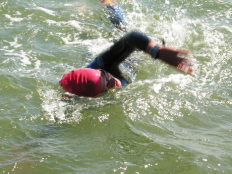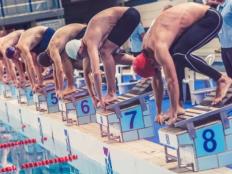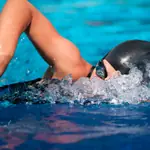5 to 6 Percent: You feel great comfort in the water. You can swim a mile with sufficient ease that it seems plausible to complete a 5K (equivalent of a half-marathon in running) or more. You feel confident about swimming in open water. If you do triathlon, you feel quite fresh at the conclusion of the swim leg and regularly achieve a respectable, mid-pack position. Your kick and breathing both feel relaxed and controlled. You can achieve small increases in pace with reasonable effort.
To reach the next level you need: A more stable and sleeker body position.
More: Perfect Your Breathing With a Better Body Position
7 to 8 Percent: You feel more at home in the water than anywhere else, and swimming feels better and is more satisfying than any other physical activity. Your stroke—including both catch and 2-beat kick—feels integrated and seamless up to about 85 percent of maximum effort and heart rate. You can swim faster, whenever you choose, with a reasonable amount of effort. Swimming a marathon distance seems completely plausible, if you devote a concentrated period of 10 to 12 weeks to prepare for it. If you compete in open water swimming (including triathlon swim legs) you regularly place in the Top 5 to 10 percent of your age group.
To reach the next level you need: Highly effective propulsion skills—particularly a firm catch and well-tuned 2-Beat Kick.
More: How to Add Propulsion to Your Stroke
9 Percent or More: If you had youth and athleticism, your efficiency would probably put you among the elite. But, in middle age or beyond, you enjoy something more valuable—a sense that you swim with a skill (even artistry) and awareness shared by few. You regularly experience psychological flow states in practice, and occasionally in competition. You virtually always feel you work with the water, even at close to maximum effort. When you lose effectiveness, it's minor. You quickly sense the cause and can easily adjust your stroke to get back in flow. You can consistently and proportionately convert an increase in strokes per length (SPL) or tempo into an increase in pace.
More: How to Sight Like a Professional Swimmer
 Search for your next triathlon.
Search for your next triathlon.
- 2
- of
- 2
About the Author

Get ACTIVE on the Go


Meet Mobile
Swim smarter: heats, lane assignments and real-time results in the palm of your hand.
Available for iOS | Android







Discuss This Article